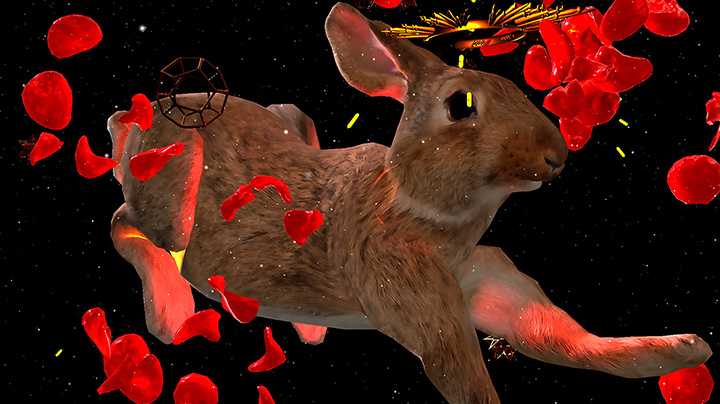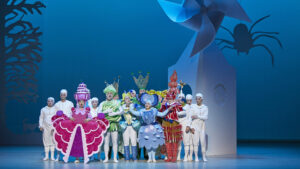Certainly, Scheib’s production represents multiple exciting firsts for the Bayreuth Festival and opera. It is the first staging from a respected institution that unveils the interactive possibilities enabled by AR’s parallel realities. While environmentalism is common thematic fodder for directors, Scheib’s Parsifal also represents a first in criticizing the greenwashing behind the battery industry’s lithium and cobalt mining practices. But such novelties ring hollow when Scheib’s ill-defined jumble of ideas and his flat-footed theatrical execution ultimately fail to resonate with Wagner’s narrative.
Scheib sets his Parsifal in a broken, post-human world ravaged by the extraction of the battery minerals that power our consumer economy. The Grail Knights of this reality are guardians of an order that deify the metals of electrification—their reverence saliently symbolized by a striking metallic monument that looms over their sacred grounds. In the first act, Montsalvat mirrors a cobalt mining site, Kundry’s balsam is a chunk of mineral ore, and the order enacts their rituals by pouring Amfortas’ blood over a blue, diamond-shaped cobalt oxide crystal–this production’s Holy grail.
It is ultimately unclear how relevant the order’s reverence for mining and stage designer Mimi Lien’s barren dystopia are to the rot that consumes the order. Maybe the knights are green technology enthusiasts who, by pivoting away from fossil fuels in pursuit of a greener economy, failed to perceive how greatly their energy source too inflicts a wound on the planet. And the Grail Knights’ resistance to technological change amid myriad environmental crises perhaps represents the corruption reflected in the narrative. It’s certainly a bizarre premise for Wagner’s plot.
Considering how Scheib’s team framed this as an environmental Parsifal, it was thus baffling how differently they portrayed the central act and its pivotal confrontation between Kundry and Parsifal. Klingsor, an androgynous figure dressed in a Barbie pink suit and heels, keeps the spear in a hip, psychedelic club populated by blonde social media influencers (proxies for the flower maidens). Are these modern-day hedonists perhaps a metaphor for our society’s overconsumption and materialism? Whatever this incomprehensible set represents unfortunately served as a poor backdrop for Parsifal and Kundry’s great existential awakening.
Much space in the program booklet is dedicated to excerpts of poetry, literature, and philosophy that paint Kundry as a powerful, self-aware woman whose position in the story is constrained by the prejudices of men. Likewise, textual references are dedicated to the discussion of Parsifal’s absence of memories and how foundational this is to his role as the plot’s “solutions guy.” How such insights of feminist agency or the empowering role of memory influence either character’s evolution, or how they motivate their interactions at the crux of the drama (or the outer acts), could scarcely be gleaned from Marlene Schleicher’s strange and purposeless dramaturgy.
Environmentalism finally returns in the final act, where the decrepit Montsalvat now occupies a wasteland poisoned by a lithium-ion pool. In the absence of the AR imagery, much of Act II proceeds like any other traditional Parsifal. The world-weary hero returns with the holy spear, Kundry atones for her past by washing his feet (albeit with the poisoned lithium water), and Gurnemanz anoints him as the order’s new king.

The sole twist occurs near the act’s end when Parsifal reveals the grail and shatters it on the ground. Parsifal guides the still-alive Kundry to the middle of the lithium pool, and as the score’s ethereal chords taper into silence, he raises his gaze and the spear upwards to the sky—signifying that the solution to the grail order’s and humanity’s corruption is solar energy!
Much more discussion could be invested in describing the directorial misfires (for instance, the inexplicable Kundry double and her relationship with Gurnemanz) in a production so thin on intellectual heft, but perhaps time and space could be better dedicated towards the production’s “cool” new AR toy. Scheib, who teaches at the Massachusetts Institute of Technology’s theater arts department, rounded up MIT Media Lab colleagues like his video and AR specialist Joshua Higgason to design the projections for Bayreuth’s staging.
The technical preparation that went into generating the imagery and spatially calibrating the glasses for each user was certainly impressive. Scheib and Higgason used a 3D mapping technology called LiDAR (Light Detection and Ranging) to record the entire Festspielhaus auditorium and stage so that each individual device can accurately position the projections for the fraction (300-odd members!) of the Bayreuth audience wearing the glasses. The team’s collaboration with a global, multidisciplinary team of visual designers yielded the sequence of graphics fed into the hardware for Scheib’s AR world.
While some imagery like the starry sky that accompanied the Vorspiel and the blue tendrils of electricity emanating from the Grail were uniquely evocative, much else of Scheib’s projections were either distracting (flowers and skulls that randomly float about), incoherent (the little red AR men who combust after embracing during the Act 1 grail ceremony), or excessively on the nose (the graphic spears that fly towards the audience). Confusing too was Scheib’s decision to leave the display bare during Wagner’s metaphysical Verwandlung sequences that seemed the perfect medium for the AR platform. Lastly, the glasses gradually became quite uncomfortable for the user, with the frames heating after a period of operation and the dark tint on the outer lenses at times obfuscating the action on the real stage.
Fortunately, the musicians who relived the drama delivered performances that partially redeemed the experience from Scheib’s confounding production. Perhaps one of the more exciting aspects of August 7’s Parsifal originated from Andreas Schager’s indisposition after the previous evening’s Tristan und Isolde. Prevented from appearing due to his respiratory infection, the Festival announced that Klaus Florian Vogt would appear in lieu of Schager. However, when Vogt’s Flugzeug was delayed, Tilmann Unger (Schager’s vocal substitute during the Tristan) appeared for the character’s brief scenes in Act I. Vogt then took over the rest of the performance from the second act onwards, assuming the clear, verbally sensitive and nuanced Parsifal that founded much of his career’s earlier Wagnerian explorations.
Georg Zeppenfeld represented a bulwark of musicality, intelligence, and diction throughout his character’s long stretches of exposition. His noble bass timbre imbued Gurnemanz’s text with a vibrant palette of color that consistently commanded attention, and his powerful benediction in Act 3 emerged as one of the evening’s noteworthy climaxes. If Ekaterina Gubanova’s top notes could occasionally tighten and her longer phrases featured a distinctive vibrato (for instance, Kundry’s evocative call during her seduction of Parsifal), her dramatic commitment and scrupulous attention to the words and music made her a riveting presence.
Derek Welton in the role of Amfortas revealed a physically robust instrument that movingly portrayed the grail king’s suffering, while Jordan Shanahan sang and enacted a menacing, villainous Klingsor. Both baritones made a positive impression during their brief scenes despite some of the bizarre direction that surrounded their characters (the gruesome video fixation on Amfortas’ wound, and Klingsor’s awkward he/she depiction in Act II). Among the cast’s minor roles, Tobias Kehrer’s sonorous Titurel, Jordan Newlin’s lyrical Knappe and Evelin Novak’s luscious first flower maiden stood out among the ensemble for their fine singing.
Pablo Heras-Casado unveiled a luminous, transparent reading of Parsifal’s score that remained dramatically taut and expressive throughout the performance, even if climactic moments that underscored the work’s mystical grandeur were at times underplayed. Heras-Casado commanded a supple baton that moved fluidly along the music’s contours, capably recreating that ethereal Bayreuth acoustic so deeply associated with this score.
Augmented reality offers exciting potential for enabling uniquely interactive theatrical experiences. While there remain challenges in deploying this nascent technology in most theaters, there is nothing that fundamentally precludes the use of personalized, superimposed imagery to reveal interesting details about a narrative, or to enhance a director’s stagecraft. However, as demonstrated by Bayreuth’s incohesive new Parsifal, directorial responsibility and integrity need to remain paramount even in the face of innovation.
Photos: Enrico Nawrath







Comments